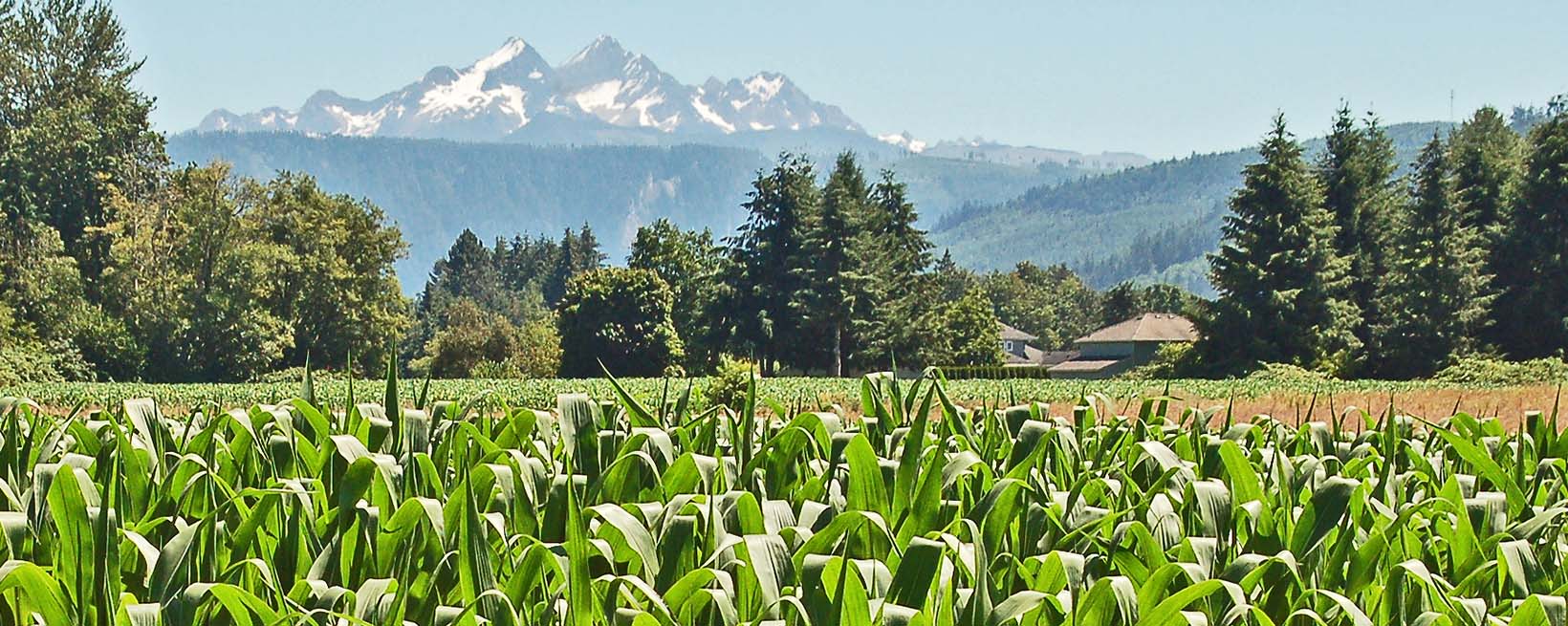
The fate of farmland in Whatcom County, near the Twin Sisters peaks, is at risk in the novel, and corn--natural, GMO, and older Indian strains--plays a key role.
Chapter 1, excerpt
I AM ON THE MOUNTAINSIDE IN THE WOODS, cutting aclump of chanterelle mushrooms, when I hear someone behind me. I’ve been alone, enjoying the damp, early golden-brown of fall, and now I turn to see a man darkly silhouetted against the low afternoon sun angling through the undergrowth.
As I get up, brushing bits of the forest floor from my jeans, he apologizes for startling me. I recognize the voice, and once I can see his face clearly, I realize it’s the geologist who’s new to town. He’s had breakfast occasionally at Lavender’s, the café I own, but we haven’t chatted much since I’m in the kitchen rather than out front with customers. His usual order—ham and eggs, biscuits, and tea, not coffee—arrives before his name.
Still, I surprise myself when I say helloin a friendly way. Since I’ve lived around here longer, surely that gives me some claim to this territory. And he works for the Baron, our nickname for the technology mogul who has bought vast swathes of the nearby mountain ridges and foothills. With all the rumors of his desires for development, he’s not too popular.
Grant—his name arrives—glances at my plastic pail half full of mushrooms, delicate golden trumpets with soil clinging to their freshly cut stems.
“Will you be serving those chanterelles at the café soon?”
“Probably tomorrow, starting at lunch. I’ll try some at home tonight, first.”
“I’ll bet the cooking is even better at your house.” He grins.
Great, a flirtatious geologist, and no one but me to appreciate his humor. He looks like a creation the forest has sprung on me, with his reddish hair, brown jacket, canvas backpack, worn jeans and boots. Except for the notepad and pen he’s holding. I nod toward these and ask if he is at work, making notes on our local rocks.
“Actually on rivulets and thermals. I’m mapping where cold water is flowing near hot steam vents, or thermals. The confluence has creative possibilities.”
Creativity doesn’t merge smoothly with geology in my mind, and I hug my arms against the damp chill. I worry that these searches might lead him to our precious local secret, a natural hot springs pool nearby. Maybe he’s even looking for it; no signs point the way, and the several paths leading to it stay narrow and lightly trodden, as we locals approach from different directions.
“What kinds of creative possibilities?” I ask.
“Geothermal energy is the main one. You probably know a plant has been proposed for lower down on the south side of Mount Baker, opposite from where we are now.”
“But surely not up here.”
“No, not here.”
We both glance at the forest of cedar, fir, and hemlock, and gaze beyond toward the steep ridges across the valley, which loom tall with gray granite and ice-ribbed glaciers.
“Geologists look at rocks and dirt, and extracting minerals, inert stuff, right?” I ask.
“And at living organisms. Dirt has billions of microscopic creatures that are alive, along with the minerals. And so do even the deepest, hottest thermal vents, even under the ocean.”
My question must have touched a nerve, for he adds that I could serve my bucket of chanterelles along with soil that’s still on their stems. “A cup of it has billions of microscopic archaea, bacteria, fungi, algae, protozoa—you could add those to the ingredients list on your menu.”
Though I laugh, I say I’ll stick to my usual cleaning routines and health department guidelines. The comment gets me thinking, though, about my work, and how cooking relies on chemical processes that lurk well below an ingredient’s surface. Soon he says it’s been nice talking, and that he’ll get on his way to the hot springs pool.
“You’re just going to have a quick look, maybe take its temperature?” Dismay has edged into my tone.
“Yeah, I’ll do some readings; they won’t take long.”
I say I’ll see him again soon—meaning at the café—and watch as he leaves on the faint trail. He is taller than I am, but not by much. He looks like a logger, thickly built and strong, big-boned.
I return to my task with a sigh because I’ve planned to have a nice, long soak after becoming chilled. It’s Tuesday, my day off from the café, a time when almost no one else goes to the pool. Usually, I can enjoy it in solitude. I stoop to cut more mushrooms, but the pleasure has seeped from the work. Still, I push deeper into the woods through brush—mainly mountain blueberries still redly unripe in deep shade—and search out more stumps and rotted logs where the mulch of ages juts up into telltale crowns over fungal caps.
Enough time passes that my fingers grow numb, and when I nick my thumb with the sharp knife—and don’t feel it—it’s past time to stop. The day is waning, and it’s wise to warm up before the long walk home. The geologist should be done, and I start up the path, the heavy pail knocking against my leg. Even if Grant is still at work, cold and fatigue are affecting my mood, and I just might assert my claim to the pool.
Soon, the faint trail becomes muddy, and the air stinks of sulfur. At first, it’s repellent, like dead animals or rotted plants. Closer, the smell is sharper, more clearly mineral in nature. Two streams, one scalding hot and the other icy cold, join to fill the pool. Over the years, the rocky, sandy basin has been scooped and deepened to accommodate six or eight people.
Page 1 of 3 Next
